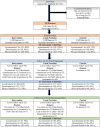Move for Life an intervention for inactive adults aged 50 years and older: a cluster randomised feasibility trial
- PMID: 38813401
- PMCID: PMC11133700
- DOI: 10.3389/fpubh.2024.1348110
Move for Life an intervention for inactive adults aged 50 years and older: a cluster randomised feasibility trial
Abstract
Background: Move for Life (MFL) is a theory-informed intervention that was developed to augment established physical activity (PA) programmes and enable inactive adults aged 50 years and older to be more active. This study examined the feasibility of MFL and sought to provide evidence of its potential for improving PA and associated health outcomes.
Methods: A 3-arm cluster randomised feasibility trial compared MFL intervention, usual provision (UP) and control (CON) groups at baseline (T0), post-intervention (T1, at 8, 10 or 12- weeks) and 6-month follow up (T2). We used purposive sampling strategies to recruit participants according to characteristics of interest. Feasibility outcomes assessed recruitment, fidelity, adherence, retention and data completion rates based on pre-set criteria. Primary outcomes were accelerometer-based moderate-to-vigorous intensity PA (MVPA) and self-reported compliance with physical activity guidelines (PAGL). Secondary outcomes included light intensity PA (LiPA), standing time, sedentary time, body composition (adiposity), physical function and psychological well-being. We used linear mixed models (continuous outcomes) or generalized estimated equations (categorical outcomes) to estimate group differences over time in the study outcomes.
Results: Progression criteria for feasibility outcomes were met, and 733 individuals were recruited. Considering a 6-month period (T0-T2), while self-reported compliance with PAGL increased in MFL relative to UP and CON and in UP relative to CON, standing time decreased in MFL relative to CON and sedentary time increased in the latter compared to UP. Waist circumference decreased in MFL relative to UP and CON. MFL outperformed UP in the Timed Up and Go Test while MFL and UP increased the distance covered in the Six-Minute Walk Test compared to CON. Psychological well-being increased in MFL relative to CON (all p < 0.05).
Conclusion: Findings show that MFL is feasible, while data are promising with regards to the potential of improving community PA programmes for adults aged 50 or more years.
Clinical trial registration: https://www.isrctn.com/Registration#ISRCTN11235176.
Keywords: body composition; community-based; energy expenditure; older adults; physical activity; physical function; well-being.
Copyright © 2024 Woods, O’Regan, Doyle, Hayes, Clifford, Donnelly, Gillespie, Glynn, Murphy, Sheikhi and Bengoechea.
Conflict of interest statement
The authors declare that the research was conducted in the absence of any commercial or financial relationships that could be construed as a potential conflict of interest.
Figures


Similar articles
-
Psychosocial effects of a behavioural augmentation of existing public physical activity programs for middle-aged and older adults in Ireland.PLoS One. 2025 Mar 4;20(3):e0318911. doi: 10.1371/journal.pone.0318911. eCollection 2025. PLoS One. 2025. PMID: 40036201 Free PMC article. Clinical Trial.
-
An evaluation of an intervention designed to help inactive adults become more active with a peer mentoring component: a protocol for a cluster randomised feasibility trial of the Move for Life programme.Pilot Feasibility Stud. 2019 Jul 9;5:88. doi: 10.1186/s40814-019-0473-y. eCollection 2019. Pilot Feasibility Stud. 2019. PMID: 31333875 Free PMC article.
-
Web-Based Versus Print-Based Physical Activity Intervention for Community-Dwelling Older Adults: Crossover Randomized Trial.JMIR Mhealth Uhealth. 2022 Mar 23;10(3):e32212. doi: 10.2196/32212. JMIR Mhealth Uhealth. 2022. PMID: 35319484 Free PMC article. Clinical Trial.
-
Randomised controlled feasibility study of a school-based multi-level intervention to increase physical activity and decrease sedentary behaviour among vocational school students.Int J Behav Nutr Phys Act. 2017 Mar 21;14(1):37. doi: 10.1186/s12966-017-0484-0. Int J Behav Nutr Phys Act. 2017. PMID: 28327174 Free PMC article. Clinical Trial.
-
Study design of 'Move More': Development and feasibility of a social-prescribing intervention to increase physical activity among inactive Danes.Scand J Public Health. 2023 Dec;51(8):1258-1265. doi: 10.1177/14034948221098929. Epub 2022 Jun 2. Scand J Public Health. 2023. PMID: 35656623 Review.
Cited by
-
Do publicly funded community physical activity programs for middle-aged and older adults in Ireland work?Eur J Ageing. 2025 Mar 18;22(1):10. doi: 10.1007/s10433-025-00847-z. Eur J Ageing. 2025. PMID: 40100440 Free PMC article.
-
Psychosocial effects of a behavioural augmentation of existing public physical activity programs for middle-aged and older adults in Ireland.PLoS One. 2025 Mar 4;20(3):e0318911. doi: 10.1371/journal.pone.0318911. eCollection 2025. PLoS One. 2025. PMID: 40036201 Free PMC article. Clinical Trial.
References
-
- World Health Organisation . Global Health and aging (2011). Available at: https://www.who.int/ageing/publications/global_health.pdf
-
- Healthy and Positive Ageing Initiative . The National Positive Ageing Strategy (2013). Available at: https://hapaidotnet.files.wordpress.com/2015/07/national-positive-ageing...
Publication types
MeSH terms
LinkOut - more resources
Full Text Sources
Medical
Miscellaneous

